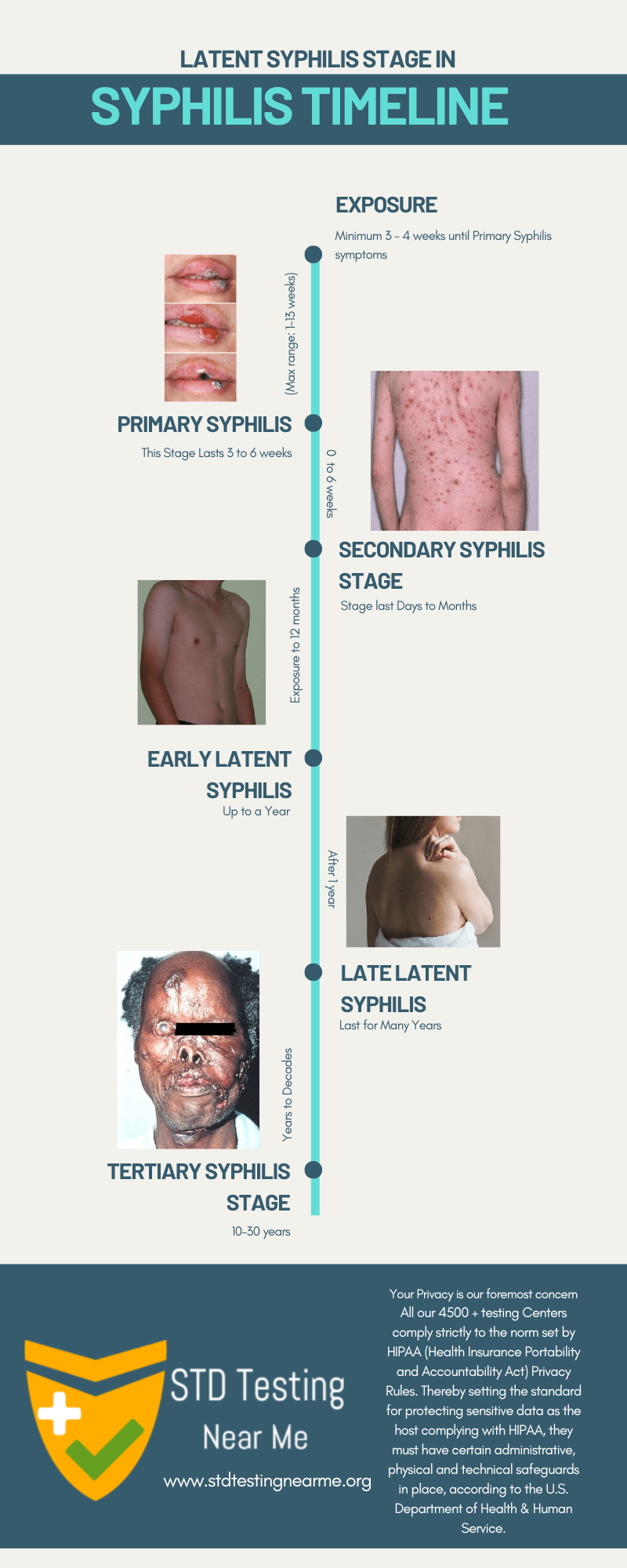Everything about Early Latent Syphilis to Late Latent Syphilis
The latent stage is when there are no signs or symptoms (asymptomatic) yet syphilis remains in the body (if not treated), that is when tested (that is positive serology).
Syphilis remains dormant during the latent syphilis stage. The latent period may be as brief as 1 year or range from 5 to 20 years.
Thus, latent Syphilis is always detected when some kind of screening or test, or diagnosis is done on the patient.
The Latent stage of syphilis occurs between secondary and tertiary syphilis. During the primary and secondary stages, the disease is somewhat contagious, and it may remain that way into the early latent stage.
The average time between exposure and onset of symptoms is 3 to 4 weeks.
Latent Syphilis (stage) can last for years and during which the bacteria remain dormant with no symptoms but positive syphilis tests.
In the latent stage, the lesions on the skin or mucous membranes can occasionally appear, and direct contact with these lesions can transmit the disease.
There are two stages within Latent Syphilis and each has different characteristics
- Early Latent Syphilis
- Late Latent Syphilis
Let’s take a look at each stage of latent syphilis in a detailed manner.
1. Early Latent Syphilis
Early latent syphilis is a form of latent syphilis when you are sure that the person contracted syphilis within the last 12 months.
What are the situations when one can refer to the stage as Early Latent Syphilis?
Early latent syphilis can be recognized through a wide variety of situations and they are as follows.
Situation 1: If a patient presents with positive serology (positive test result) and tells the doctor that their first sexual contact happened within the last 12 months then you can be pretty sure that they’re still in the early latent phase.
Situation 2: Another situation is if they’ve had sexual contact with their partner who was diagnosed with syphilis during this time frame as well.
Situation 3: Another situation is if the patient can recall symptoms that are consistent with primary or secondary syphilis during the last 12 months.
Situation 4: If a person had syphilis and was treated and can demonstrate increased titers on labs during the last 12 months
2. Late Latent Syphilis
If a patient does not meet the above criteria for early latent syphilis then they’re automatically placed in the late latent syphilis stage.
This is usually when a person has been tested positive for syphilis but not entirely sure when exactly they contracted it.
Also read: See how Syphilis on the tongue looks like
Why do we differentiate early latent syphilis from late latent syphilis?
The reason why we distinguish between these two stages in the first place is that it actually affects the treatment regimen.
People who are in late latent syphilis need longer treatment.
Syphilis timeline explaining all the stages of syphilis in an Infographics

Syphilis Treatment
Syphilis is diagnosed by serological tests for antibodies against the bacteria in blood or cerebrospinal fluid samples.
Dark-field microscopy may be used to visualize spirochetes from chancre exudates or lymph node aspirates.
Most syphilis cases can be treated with penicillin.
Earlier stages require only a single injection. Additional injections are needed for later stages.
Some other antibiotics may be used for non-pregnant patients who are allergic to penicillin. Pregnant women with penicillin allergy should undergo desensitization so they can be treated with penicillin.
Patients may experience a reaction, known as the Jarisch-Herxheimer reaction (JHR), on the first day of treatment. The reaction usually subsides within 24 hours, but patients must be warned and observed.
Although we see the suffering in the Latent stage of syphilis is less, the patient looks healthy and feels healthy, yet he/she is seropositive which means he/she is being tested positive for syphilis. So without mistaking it for the cure. The latent syphilis stage must be used to treat syphilis and prevent it from going to its next stage which is a more dangerous and even deadlier, the tertiary stage. So one should get tested for Syphilis and if tested positive (with no symptoms) should begin treatment immediately
References
Syphilitic book vo1ume 2 para 3: https://www.webmd.com Syphilis research data, table No 2, row 3, line 44 Syphilis PMC article: https://www.ncbi.nlm.nih.gov/pmc/articles/PMC1779891/


